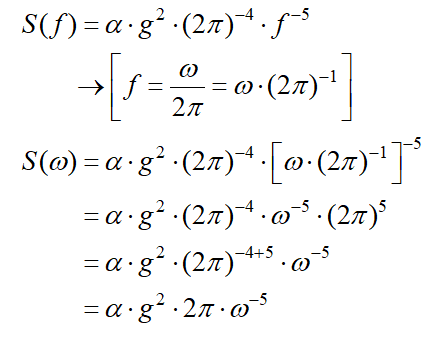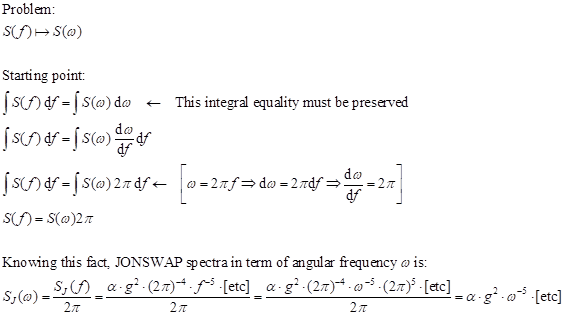Giu.seppe
Civil/Environmental
- Aug 25, 2017
- 5
Hello to all. Sorry for my english, I'm an italian civil engineering student.
I have a question about the JONSWAP spectrum. We know that the JONSWAP spectrum, in terms of frequency, is:
S(f) = α g2 (2π)-4 f-5 exp {-1.25 (fm/f)4} γexp {-(f-fm)2/(2σ2fm2)}
Now I would like to write S in term of ω: f= ω/(2π). The first piece of S (f) becomes:
S(ω) = α g2 (2π)-4 f-5 [etc.]
= α g2 (2π)-4 [ω/(2π)]-5 [etc.]
= α g2 (2π)-4 ω-5 (2π)5 [etc.]
= α g2 (2π) ω-5 [etc.]
The problem is that in all the books (and also on Wikipedia) it is written:
S (ω) = α g2 ω-5 [etc.]
without the remaining 2π in my passages. What am I missing?
Thanks for your help!
I have a question about the JONSWAP spectrum. We know that the JONSWAP spectrum, in terms of frequency, is:
S(f) = α g2 (2π)-4 f-5 exp {-1.25 (fm/f)4} γexp {-(f-fm)2/(2σ2fm2)}
Now I would like to write S in term of ω: f= ω/(2π). The first piece of S (f) becomes:
S(ω) = α g2 (2π)-4 f-5 [etc.]
= α g2 (2π)-4 [ω/(2π)]-5 [etc.]
= α g2 (2π)-4 ω-5 (2π)5 [etc.]
= α g2 (2π) ω-5 [etc.]
The problem is that in all the books (and also on Wikipedia) it is written:
S (ω) = α g2 ω-5 [etc.]
without the remaining 2π in my passages. What am I missing?
Thanks for your help!


